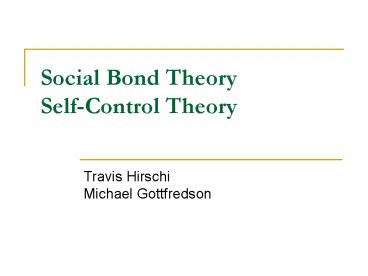Social Bond Theory SelfControl Theory - PowerPoint PPT Presentation
1 / 14
Title:
Social Bond Theory SelfControl Theory
Description:
Commitment involves the time, energy, and effort expended in conventional lines ... Tautological. Different classes of criminals. Ecological / Individual differences ... – PowerPoint PPT presentation
Number of Views:741
Avg rating:3.0/5.0
Title: Social Bond Theory SelfControl Theory
1
Social Bond TheorySelf-Control Theory
- Travis HirschiMichael Gottfredson
2
Social Bond TheoryTravis Hirschi
- Social Process Theories
- Social Control Theories
- Causes of Delinquency (1969)
- Social Bond Theory
- Attachment
- Commitment
- Involvement
- Belief
3
Social Bond TheoryTravis Hirschi
- Attachment refers to a persons sensitivity to
and interest in others.
4
Social Bond TheoryTravis Hirschi
- Commitment involves the time, energy, and effort
expended in conventional lines of action, such as
getting an education and saving money for the
future.
5
Social Bond TheoryTravis Hirschi
- Heavy involvement in conventional activities
leaves little time for illegal behavior.
6
Social Bond TheoryTravis Hirschi
- People who live in the same social settings often
share common moral beliefs they may adhere to
such values as sharing, sensitivity to rights of
others, and admiration for the legal code.
7
(No Transcript)
8
Testing Social Bond Theory
- Hirschis Supporting Research
- Youths who were strongly attached to their
parents were less likely to commit criminal acts. - Commitment to conventional values, such as
striving to get a good education and refusing to
drink alcohol and cruise around, was indicative
of conventional behavior. - Youths involved in conventional activity, such as
homework, were less likely to engage in criminal
behavior. - Youths involved in unconventional behavior, such
as smoking and drinking, were more delinquency
prone. - Youths who maintained weak and distant
relationships with people tended toward
delinquency. - Those who shunned unconventional acts were
attached to their peers. - Delinquents and nondelinquents shared similar
beliefs about society.
9
Testing Social Bond Theory
- Opposing Views
- Friendship
- Not all elements of the bond are equal
- Deviant peers and parents
- Restricted in scope
- Changing bonds
- Crime and social bonds
10
Self-Control Theory Travis Hirschi Michael
Gottfredson
- Latent Trait Theories
- General Theory of Crime (GTC)
- A General Theory of Crime (1990)
- Self-Control Theory
11
Self-Control Theory Travis Hirschi Michael
Gottfredson
- Differences of Social Bond Theory Self-control
Theory - A General Theory of Crime (1990)
- Integration of
- Biosocial
- Psychological
- Routine activities
- Rational Choice Theories
12
Self-Control Theory Travis Hirschi Michael
Gottfredson
- In GTC Gottfredson and Hirschi consider the
criminal offender and the criminal act as
separate concepts
13
(No Transcript)
14
Self-Control Theory Travis Hirschi Michael
Gottfredson
- Criticisms
- Tautological
- Different classes of criminals
- Ecological / Individual differences
- Racial and gender differences
- Moral beliefs
- Peer influence
- People change
- Modest relationship
- Cross-cultural differences
- Misreads Human nature

